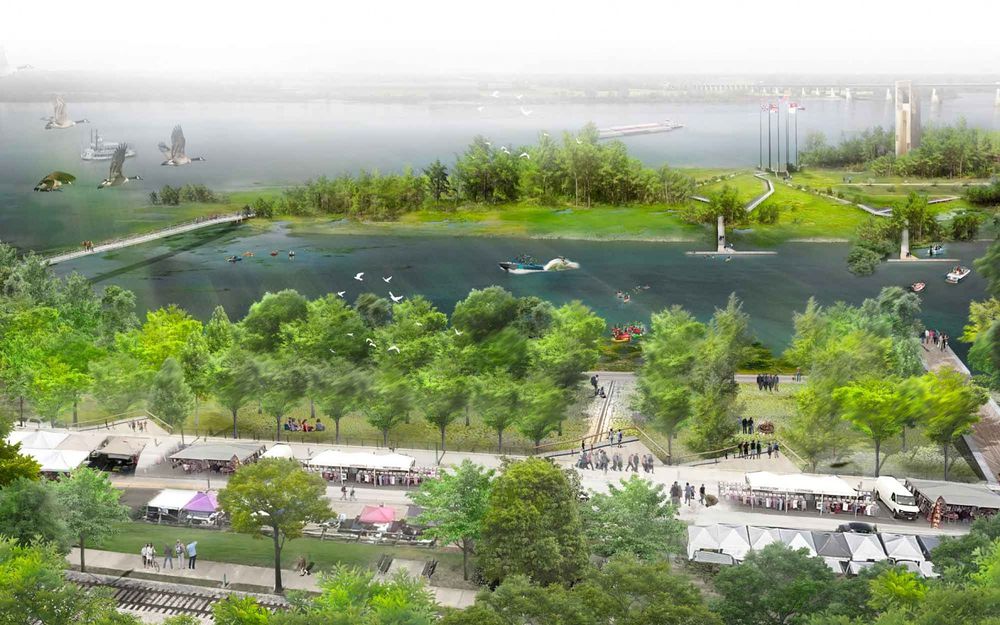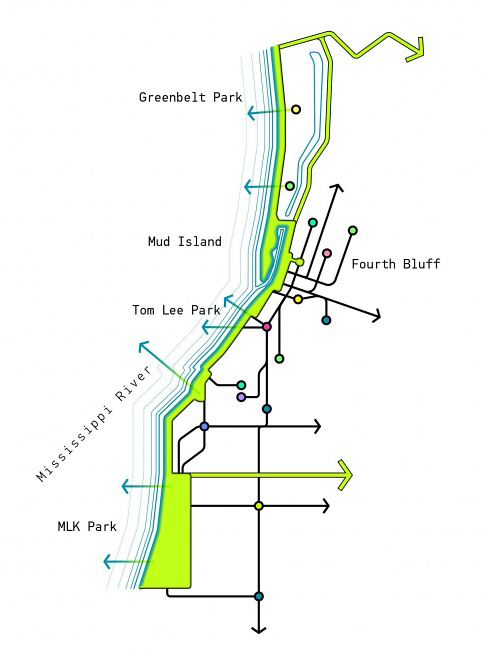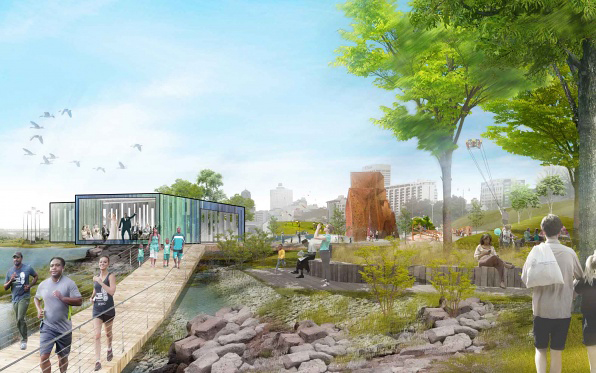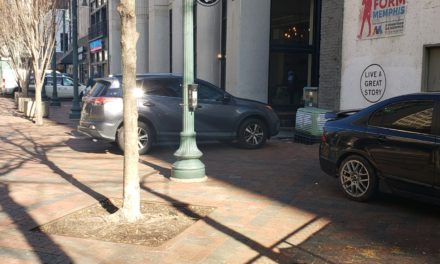In light of the discussion about the future of Tom Lee Park, we are reposting a commentary from July 24, 2017, saluting Mayor Strickland for his leadership for a more vibrant riverfront, the fulfillment of decades of recommendations that were not implemented:
Since 2005, when we began this blog, we have written just shy of 3,500 posts; 200 of them have included the riverfront.
That’s why it should be no surprise that we are excited by the Studio Gang concepts unveiled last week for a reimagined, reinvigorated, revitalized six miles of Memphis riverfront, the city’s most important natural resource and distinctive opportunity.
In these dozen years, we have blogged about the potential of a vibrant riverfront to reposition Memphis and to update and amplify its brand nationally. We have written about the decades of lost opportunity by focusing on project rather than place.
We have opined about the lack of connectivity that keeps the riverfront a broken whole. We have suggested that while ideas about the future of Memphis’ first great place may spark disagreements, surely there is consensus that something has to be done to make more of what the riverfront can be and do for the city.
Context
Since the Center City Commission Development Plan for the Riverfront Sub-Area by the celebrated Denise Scott-Brown and respected local architect James Williamson in 1987, there have been 18 other plans dealing with the riverfront, and while there have been a few improvements made over the year, they have not produced the kind of vibrancy that should sustain the area.
In issuing her 1987 comprehensive plan for downtown (disclosure: I was chair of committee that selected her firm for the work), Ms. Scott Brown’s description of her work could also define the work by Studio Gang of Chicago and New York. Ms. Scott Brown said that she was an “urban detective” but she was struck particularly by the “desolate cobblestones” and the history of the riverfront.
Ms. Scott Brown was one of the most erudite and interesting people we’ve ever met, but ultimately, her plan was too much of a light touch regarding the waterfront although her role in killing plans for the FAP-3 interstate connector linking I-40 and I-55 are reason enough to celebrate her contribution. It was, she said, a “Pyrrhic victory because they took all the money and spent it in the suburbs.”
In 2012, Memphis Mayor A C Wharton Jr. and Housing and Community Development Director Robert Lipscomb approved our recommendation for author, New Urbanist, and architect Jeff Speck to be hired to review previous riverfront plans and recommend actions that were small scale and actionable in the near term. However, in the wake of his recommendation, little was done.
The Starting Point
In presenting his report, Memphis Riverfront Analysis and Recommendations, Mr. Speck cited the need for a more in-depth, comprehensive planning approach for the riverfront and that is exactly what Studio Gang, led by Gia Biagi, its principal of Urbanism and Civic Impact, has done with its six-mile, five-zone approach defining a “connective network of spaces and opportunities that enrich the human experience.”
And yet, nothing is written in stone, as explained by Alan Crone, top adviser to Mayor Jim Strickland and head of the Mayor’s Riverfront Task Force and who ably guided the riverfront committee’s work. Mr. Crone pointed out that Studio Gang provided options and that release of the firm’s report is a “starting point” whose final recommendations will be refined in coming months by community input.
Already, Studio Gang’s work – and national reputation – has resulted in significant attention. Curbed wrote that the firm’s “latest project, a scheme to redesign and redevelop a six-mile section of riverfront in Memphis, Tennessee, offers another showcase of the studio’s unique philosophy of blending the natural and artificial.
“Along with the Studio’s recent plans for a prototype (Chicago) police station and Philadelphia neighborhood, this new park plan shows the firm is also becoming skilled at community-directed urbanism. The scheme was the result of extensive community surveys and research, with thousands of residents, as well as interviews with Memphis Mayor Jim Strickland’s riverfront task force and deep dives into previous attempts to redesign the Mississippi riverfront. Focused on connecting the city and its residents with each other and the river, it’s a forward-thinking look at public design, and an attempt to create a signature civic gathering space.”
Milestone Interest in Memphis
It’s hard for us to recall any report, plan, or study about Memphis that has ever been so lovingly and positively reported or that has such profound aspirations to set national standards. Now, all it takes is what we have provided precious little of over the past 35 years – action.
That’s the most encouraging indicator from this process. We can think of no time in recent history when more funders and leaders were aligned to make something happen. The relatively recent entry into Memphis by the Kresge Foundation continues to write a new chapter in ambition and critical thinking. We wrote about this in December and the momentum unleashed by this $3.6 billion foundation’s interest in Memphis seems to be building.
It seems highly possible that we will look back to the day as a milestone when Kresge Foundation – which has entreaties for help from cities everywhere – decided that Memphis deserved its special help. That it is supported and joined in the riverfront work by the Hyde Family Foundation – which is behind so much good that happens here – and the involvement of the Riverfront Development Corporation bode well for future action.
None of this would have happened, however, if it had not been for Mayor Strickland, whose stamp of approval was required to set this process in motion. It belies criticisms that being “brilliant at the basics” rules out concern about improved livability and improved urban design.
Stitching New Fabric
We are particularly impressed that the riverfront report demonstrates a deft touch, in particular saluting the environmental issues that have so often been a point of division in moving ahead. Not only did the report honor the existing environment, it also set ecological restoration as a priority. This is a powerful lesson learned at Shelby Farms Park, where a planning principle was that it takes people to restore ecologies that people disrupted.
More to the point, the concepts are built on the belief that that in stitching together underused public assets on the riverfront, we are doing more than mending broken connections, we are in fact creating a new civic fabric as the riverfront comes to not only symbolize the city we once were but the city we want to be.
There is much to like in the Studio Gang report, and we particularly like the way it addressed the five zones – Fourth Bluff, Mud Island, Tom Lee Park, M.L.K. Park, and Greenbelt Park. If you’ve followed this blog at all, you know we have special passions for Tom Lee Park and Martin Luther King Jr. Riverside Park.
In May, 2016, we wrote, “Finding the Park that Martin Luther King Riverside Park Wants To Be,” which urged improvements for this magnificent, undervalued Memphis park. In January, 2012, we wrote, “Tom Lee Needs A Rescue,” and hoped for a time when the “moonscape” of Tom Lee Park would be modified to include “outdoor rooms.” In May, 2013, we summarized Mr. Speck’s report, “Upgrading Two Parks for a Better Riverfront.”
Of course, those are only a few of dozens and dozens of riverfront blog posts, but suffice it to say that we are genuinely excited about the road ahead, and after so many plans and so many false starts, that may be our strongest endorsement of all to the quality of the Studio Gang work.
**
Join us at the Smart City Memphis Facebook page for daily articles, reports, and commentaries that are relevant to Memphis.








The riverfront certainly needs a lot of help. It is such a great asset but has been badly neglected and past projects like Beale Landing and Mud Island are both very poorly done. Six miles of riverfront is huge so I predict the grand plan will never happen only small parts like Tom Lee park.
This being Memphis it’s likely to never happen. In addition to the riverfront we need to work on the many derelict sections of downtown as discussed last week. And I agree too that something really needs to be done about the trolleys and especially the Sterick and 100 North Main buildings. They are both big examples of downtown urban blight on a massive scale.
Priority number 1 is to move forward with the cobblestones renovation. Quickly work out the issues about crosswalks with the state and start construction. This gigantic eyesore has been with us far too long.
Looking through the renderings I am struck at the lack of cycling infrastructure. If the River Crossing has taught us anything it’s that bikes play an important role. With the advent of bike share expect more bikes roaming the streets and pathways of downtown.
This proposal is well beyond any possibility because the funds just aren’t there now or in the future. The city needs to think smaller and be more realistic about the riverfront. Fix the cobblestones, improve Tom Lee Park and do something about Riverside Drive please. All this looks great but there are just not enough funds for this Studio Gang proposal.
The alignment of interests suggests a heightened priority for moving ahead with recommendations and funding to get them done. As we said, this is a deft approach and seems imminently doable.
We truly need funds for more police on the streets and more money for public school. Not for cosmetic fixes along the river. Crime is out of control and our schools are the worst.
I want to be excited too and I so much appreciate your enthusiasm but I remain quietly hopeful and skeptical. We lack a sense of urgency and that lack of urgency sends so many great plans to collect dust. I find it insane that our trolleys have sat out of commission for as long as they have.
Anonymous 3:34: City of Memphis doesn’t fund schools and police receive $250 million a year. Successful cities do multiple things at the same time, and we can too.
I respect the fact that Studio Gang did not include “large architectural features” and that they understand the value of green spaces. However, looking over their mountain of reference material reviewed for this concept, I was disappointed to see they suggested disrupting thus destroying the historical cobblestone landing to plant the Cobble Grove. This alone is not feasible for so many reasons. They lost me at the suggestion of yet another “study” of the traffic flow on Riverside Dr.
I think we need to start by repairing the already existing problems like the cobblestones, Tom Lee Park, Mud Island (is it even still open?), the landscaping and doing something to reduce traffic on Riverside Drive. Bike lanes are also needed. Those things alone would help immensely. This proposal is far too grandiose and certainly far too expensive. Let’s be more realistic about what we can afford. There are lots of other priorities for scarce public funds.
Keep in mind that these are ideas and suggestions, not a “plan”. The document is merely a framework to help the community make decisions. Even if the community were to get behind all of the ideas, they would be implemented incrementally over time as funding was secured.
As time progressed, some ideas might not make the cut. Others would be modified by changes in circumstance or context, such as adjacent private development. In short, Studio Gang has looked at the riverfront with fresh eyes and a new perspective, and pointed out a direction in which we could go that they believe would be successful. We should give it due and thoughtful consideration before cheerfully identifying all the reasons why we’re so sure it won’t work.
The reason this won’t work is because there isn’t enough $$$!
Too much has already been wasted on studies and proposals and consultants galore. There are so many failed and poorly done public projects and many involve downtown and the riverfront.
This is just the way things always roll in Memphis. Not much gets done and what does is mostly poorly executed
The current condition of the riverfront and downtown reflect the fact that Memphis is a poverty stricken city and has been declining for about 40 years. There is a great deal of potential that has never been realized. Until the core issues of poverty and crime are addressed all the cosmetics in the world won’t help.
In keeping with the purpose of the grant, this isn’t about cosmetics. This is about creating common ground where the walls of economic and social segregation can be broken and a stronger sense of shared purpose forged. This seems the essence of what we need most.
To me, the key to getting the riverfront right is connectivity, both end-to-end and from the main downtown area injection points: South Main, the Beale-to-Union tourist area, the Convention Center area, and Pyramid/Pinch. Whether you are an urban-dweller without a car, a bike enthusiast, or a tourist who wants to park their car in a downtown hotel garage and forget about it for the weekend, driving shouldn’t be the most convenient way to get to the riverfront.
Improvements to the riverfront will need to be maintained as many are already neglected. As far as access, pedestrian bridges are needed to connect the bluff to the riverfront making it safe to cross Riverside Drive. Chicago installed a sculptural pedestrian bridge to connect Millennium Park to Maggie Daily Park over Columbus Drive making it safe for families to cross a busy street.
I took my kids to Tom Lee just today. There used to be a nice little splash pad park along the river right at the river boat dock. It’s still there, but it is in great disrepair. None of the water features work. There was grass growing all over the park, broken glass, dog feces – EVERYWHERE. The giant fish “Big John” that was made for kids to climb over and through is torn apart inside and out. The awnings covering the seating areas are gone.
This is the first area you come to at the foot of Beale Street. All the traffic to the riverboats pass by it. It was at one time, a great little park for kids. We were the only folks there for the ten minutes we stayed today. Packed up and went to Overton instead.
It’s an absolutely terrible look for the front door of Memphis. I understand the future of Tom Lee is still up for debate, but one would think what is there would be maintained in the interim.
The corporate and real estate interests have decided: the park will be built! Little people who care about things like the cost of maintenance, the terrible record of these “partnerships,” and the sterling example of the ugly money pit that is Beale Street Landing need to bow down before their billionaire superiors. Get in line, peasants, the corporate interests and their hand-picked web of consultant-lackeys have spoken!
Prediction: 10 years from now Tom Lee Park (if it is allowed to keep its name) will join Beale Street Landing and Mud Island as a crumbling money pit that “nobody could have foreseen.” The corporations will then find something else (possibly a bailout of the Crosstown Concourse or this new “Snuff” district? or maybe the Pyramid after Bass Pro tires of it?) to demand that we pour public money into. And Memphis will continue to play second fiddle to Nashville because of the enlightened leadership of the current corrupt corporate cabal.
Maybe I’m being young and naive, but I just graduated and moved back home to start a career and plant deeper roots here. I’m very hopeful and excited for the future of Memphis. What about the investments cities like Chattanooga and Louisville saw after they invested in their riverfronts? I’m tired of seeing all this “it won’t work here because it’s Memphis” mentality. I plan on spending my life in this city trying to make it better for everyone because it’s my home, I love it, and I want to show other people why they should love it, too. Also, the MRPP isn’t the RDC. They are a new brand under new leadership with renewed goals. In my opinion, they have already proven to be more successful than the RDC with things like the River Garden and getting more people out to Mud Island with things like Vibe on the Island and the new sign (as more people visit, there will probably be more incentive to invest in it). I think we should give them more of a chance and have a little more faith. If things don’t work then at some point we can try again, but doing nothing sure isn’t going to fix anything.